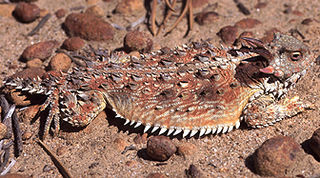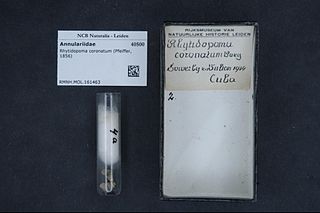Related Research Articles

The gastropods, commonly known as snails and slugs, belong to a large taxonomic class of invertebrates within the phylum Mollusca called Gastropoda.

The coast horned lizard is a species of phrynosomatid lizard endemic to Baja California Sur in Mexico. As a defense the lizard can shoot high pressure streams of blood out of its eyes if threatened.

Sea snail is a common name for slow-moving marine gastropod molluscs, usually with visible external shells, such as whelk or abalone. They share the taxonomic class Gastropoda with slugs, which are distinguished from snails primarily by the absence of a visible shell.

Clithon is a genus of freshwater snails or brackish snails that have an operculum, aquatic gastropod molluscs in the family Neritidae, the nerites.

Columbarium is a genus of deepwater sea snails, marine gastropod molluscs in the family Turbinellidae, the pagoda shells.

Freshwater snails are gastropod mollusks which live in fresh water. There are many different families. They are found throughout the world in various habitats, ranging from ephemeral pools to the largest lakes, and from small seeps and springs to major rivers. The great majority of freshwater gastropods have a shell, with very few exceptions. Some groups of snails that live in freshwater respire using gills, whereas other groups need to reach the surface to breathe air. In addition, some are amphibious and have both gills and a lung. Most feed on algae, but many are detritivores and some are filter feeders.

Nassarius coronatus, common name the crown nassa or the coronated dog whelk, is a species of sea snail, a marine gastropod mollusc in the family Nassariidae, the Nassa mud snails or dog whelks.
Vexillum coronatum is a species of small sea snail, marine gastropod mollusk in the family Costellariidae, the ribbed miters.
Coronium acanthodes is a species of sea snail, a marine gastropod mollusk in the family Muricidae, the murex snails or rock snails.
Coronium elegans is a species of sea snail, a marine gastropod mollusc in the family Muricidae, the murex snails or rock snails. It is found off the southeastern coast of Brazil.
Coronium oblongum is a species of sea snail, a marine gastropod mollusk in the family Muricidae, the murex snails or rock snails.
Coronium is a genus of sea snails, marine gastropod mollusks in the family Muricidae, the murex snails or rock snails.

Trophoninae is a subfamily of predatory sea snails, marine gastropod mollusks in the family Muricidae, the rock snails and their allies.

Alecton discoidalis is a species of firefly in the beetle family Lampyridae, commonly known as the Cuban endemic firefly. The larvae of this species are predators on both pulmonate and operculate land snails. Alecton discoidalis is the type species of the genus Alecton.

Rhytidopoma coronatum is a species of an operculate land snail, terrestrial gastropod mollusk in the family Pomatiidae.

Sclerodactylidae is a family of sea cucumbers, marine invertebrates with elongated bodies, leathery skins and tentacles.
Calliostoma coronatum is a species of sea snail, a marine gastropod mollusk in the family Calliostomatidae.
Buccinum coronatum is a species of sea snail, a marine gastropod mollusk in the family Buccinidae, the true whelks.

Terrestrial molluscs or land molluscs (mollusks) are an ecological group that includes all molluscs that live on land in contrast to freshwater and marine molluscs. They probably first occurred in the Carboniferous, arising from freshwater ones.
References
- 1 2 Coronium coronatum (Penna-Neme & Leme, 1978) . Retrieved through: World Register of Marine Species .